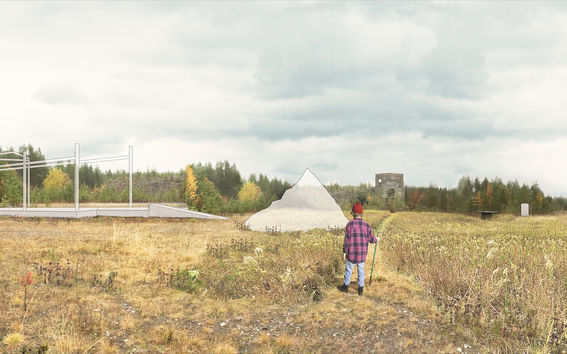Landscape architect Kaisla Rahkola receives Lappset prize

The mining industry produces both a formal industrial heritage and an unintentional and contradictory cultural heritage that we have not intended to leave to future generations. In her Master’s thesis Traces from the past – landscape historical narration in the Misi-Raaka Park of Natural Destruction Rahkola studies the disused Misi-Raakajärvi iron mine located in Kemijärvi, Lapland, Finland, and its post-industrial landscape, which is intertwined with natural processes.
In her work, Rahkola considers how the legacy of industrial activities that destroy nature and the environment, and the traces left by these industries, should be addressed through landscape architecture.
According to the Lappset committee, the subject of the thesis is of social importance.
‘The work is a valuable and stimulating contribution to the debate on the landscape impacts and environmental damage of the mining industry. It highlights the role of landscape architecture in interpreting and dealing with the difficult cultural heritage of the post-industrial landscape’, said the jury.
Rahkola's work focused on the narrative nature of the mining landscape, i.e. making landscape history visible and understandable. She grounded the topic in a historical analysis of the landscape and a literature review of post-industrial heritage sites. In the planning part of the work, Rahkola used the narrative methods she had developed: framing the experience through routes, views and resting places, and using concrete and symbolic clues from the past. These methods can also be used to present landscape history more broadly.
The Lappset scholarship is a prize for the best Master’s thesis in landscape architecture. It is awarded annually to the author of the best thesis in the Aalto University's Landscape Architecture programme. The prize amounts to EUR 2 000 and is donated by Lappset Group Oy.
The thesis Traces from the past – landscape historical narration in the Misi-Raaka Park of Natural Destruction was supervised by Professor Ranja Hautamäki and supervised by landscape architect Matleena Muhonen and architect Maiju Suomi. The work was carried out as part of The Park of Natural Destruction project by the IC-98 artists (Patrik Söderlund and Visa Suonpää), funded by the Kone Foundation.
Contact:
Landscape architect Kaisla Rahkola
kaisla@nomaji.fi
+358 (0)50 9177334
Associate ProfessorRanja Hautamäki
Aalto University School of Arts, Design and Architecture
ranja.hautamaki@aalto.fi
+358 (0)505232207
Read more news

Research Council of Finland establishes a Center of Excellence in Quantum Materials
The Centre, called QMAT, creates new materials to power the quantum technology of coming decades.
Two Unite! Seed Fund projects involving Aalto secure top EU funding
Two prestigious EU grants have been awarded to projects that were initially supported with Unite! Seed Funding. Both projects involve Aalto.
Major funding powers development of next-generation machine technology aimed at productivity leap in export sectors
The BEST research project is developing new types of sealing, bearing, and damping technology.






